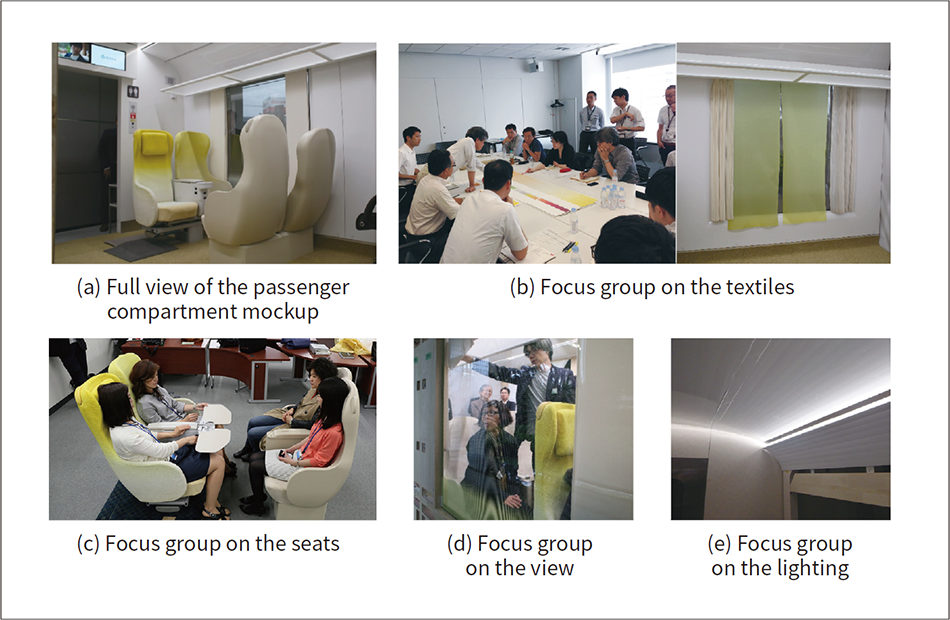New Seibu Limited Express Train 001 Series Laview Harmonized with both Urban and Natural Surroundings
Highlight
The development of Seibu Railway Co., Ltd.’s new limited express 001 series started out of the necessity to replace the older New Red Arrow Seibu 10000 Series. This coincided with the 100th anniversary of the company’s Ikebukuro Line, which runs between Ikebukuro Station and Hanno Station, leading to the decision to adopt a new flagship train that would mark the beginning of the company’s second century. Seibu Railway decided to go in a new direction in the development of this limited express train, entrusting its design to world-renowned architect Kazuyo Sejima, and including Hitachi to handle manufacturing of the rolling stock in a three-way project. This article describes the development of the new limited express Laview through this project, together with the key features that emphasize the power of its design.

Introduction
Recent years have seen the development of many types of rolling stock that emphasize their visual designs. Seibu Railway Co., Ltd.’s latest limited express 001 series Laview is the successor to the New Red Arrow 10000 Series. It features a spherical front, a silver body that blends into the scenery, large windows to enjoy a panoramic view, and an interior in which passengers can feel at home. All in all, the design has achieved a totally new type of rolling stock (see Figure 1). The following section describes how the new limited express Laview was developed and designed based on the A-train*1 concept under the design supervision of world-renowned architect Kazuyo Sejima.
Fig. 1—Exterior of Seibu Railway 001 Series Train Laview
 Hitachi used its A-train concept as the basis for developing Laview as a new, never-before-seen type of rolling stock to blend into urban and natural surroundings. The rolling stock began operation in 2019.
Hitachi used its A-train concept as the basis for developing Laview as a new, never-before-seen type of rolling stock to blend into urban and natural surroundings. The rolling stock began operation in 2019.
- *1
- Hitachi’s rolling stock concept. A key feature is the double skin construction with aluminum extruded sections in a square hollow section profile.
Overview of the 001 Series
Design Concept
The year 2015, when development work began on the 001 series, was the 100th anniversary of the opening of the Ikebukuro Line of Seibu Railway, linking Ikebukuro Station in Tokyo and Hanno Station in neighboring prefecture, Saitama. The series was designated “001” as a reversal of “100,” to express that it would formally be known as the “train that marks the beginning of Seibu’s second century.” The “00” part also incorporates the meaning of the infinity symbol (∞). The design concept consisted of the following three main points, to realize a totally new type of rolling stock for the next century.
- An express train that softly blends into the scenery in urban or natural surroundings
- An interior in which passengers can feel at home
- Express train that creates new value to become not just a means of transportation, but the destination itself
Basic Specifications
The configuration of the rolling stock is shown in Figure 2 and the main specifications are shown in Table 1. The rolling stock consists of an eight-car configuration. The width, door positioning, functions, and performance will allow it to be used on other railway companies’ lines in the future. The front exterior of the rolling stock and interiors of the driver’s cab, passenger compartments, and accessible toilets are shown in Figure 3.
The carriages are made from an aluminum alloy, with a double-skin structure of extruded sections. Friction stir welding (FSW) was used to create a tough, lightweight exterior with minimal warping. The special coating was used to create a design that softly blends into the scenery in urban or natural surroundings.
The driver’s cab is equipped so that it can be used on other railway companies’ lines, and has side windows in consideration of the driver’s field of vision. The passenger compartments have large windows with bright white walls together with seats in a warm yellow tone. The seats are thoroughly different from those previously used in express trains, designed to be like sofas to gently mold themselves to the body, with manually movable cushions that can be adjusted to the user’s height, and with a retractable table built into the armrest. Indirect lighting from the simple curved ceiling provides plentiful yet gentle illumination. The lights also change color depending on the time of day, creating an interior where passengers can feel at home.
Sanitation is provided by large accessible toilets incorporating a universal design, with baby changing facilities and toilets for women with full-length mirrors on the backside of the doors. There are also powder rooms with full-length mirrors and magnifying vanity mirrors making it easier to put on makeup, as well as handheld hair dryers and electrical sockets, meeting a wide range of needs.
Table 1—Main Specifications of the Rolling Stock
 Shows the main specifications of Laview.
Shows the main specifications of Laview.
Fig. 3—Exterior of Front End, Interiors of Driver’s Cab, Passenger Compartments, Accessible Toilet
 (a) The rounded design of the front end creates a gentle impression. (b) The driver’s cab is in a T-shape, surrounded by a single-handle control stand and instrumentation panel. (c) The passenger compartments are gentle spaces where each person can comfortably spend their own time. (d) The accessible toilet is spacious enough for easy use by a wide variety of passengers, and is ostomate-friendly.
(a) The rounded design of the front end creates a gentle impression. (b) The driver’s cab is in a T-shape, surrounded by a single-handle control stand and instrumentation panel. (c) The passenger compartments are gentle spaces where each person can comfortably spend their own time. (d) The accessible toilet is spacious enough for easy use by a wide variety of passengers, and is ostomate-friendly.
Realizing the Design
Front-end Shape
Architect Sejima’s image of the 001 series is shown in Figure 4, while Figure 5 shows the verification details of the front end. Wanting to use a large window at the front to give the driver a better field of vision, a series of prototypes were made in cooperation with a glass manufacturer to find feasible sizing and curvature. Thought was given to every aspect, including wipers that could follow the shape of the curved glass, a connecting system to couple it with other trains in case of accidents, the front-end skirts, and designs for opening and closing gangway connections. Finally, tripartition glass with a curvature radius of 1,500 millimeters was adopted while other factors were tested. The glass was found to conform to specifications in optical distortion tests for safety glass used in rolling stock, and the actual visibility was also confirmed. The glass was set in a jig at the same angle it would be mounted to verify conditions simulating day and night. In one example, a light was placed three meters in front of the glass to simulate a signal to check for distortions that prevented viewing outside the train. The wipers were tested on a full size piece of glass for their durability and ability to follow the curvature. The range of motion of the wipers was also adjusted with the customer, with verification to confirm the range combined with stress testing. The rounded shape at the front of the driver’s cab placed limits on the space for housing equipment, but an innovative arrangement succeeded in maintaining the design and functionality. After advance confirmation using a simple mockup, a full-size model was built so that the customer and designer could verify the driver’s field of vision, operability, flow of movement, and so on, to spot any problems and incorporate improvements in the design. The structure of the front-end was given a spherical shape using machining. One method to do this is to combine bent sheet metal overall with machined materials in part, but because the roundness extends over the entire structure, it was decided to comprehensively use machining for the whole structure to ensure productivity and quality.
Fig. 4—Image of the 001 Series
 The front end is shaped spherically to give a gentle impression, while the color of the train blends in with urban or natural surroundings, faintly reflecting the surrounding scenery.
The front end is shaped spherically to give a gentle impression, while the color of the train blends in with urban or natural surroundings, faintly reflecting the surrounding scenery.
Fig. 5—Verification Details for the Front End
 Mockups (a) to (d) were used to examine and verify any issues with the driver’s field of vision, operability, or flow of movement, incorporating improvements into the design. Machining was used for the entire front-end structure shown in (e) to realize the spherical shape.
Mockups (a) to (d) were used to examine and verify any issues with the driver’s field of vision, operability, or flow of movement, incorporating improvements into the design. Machining was used for the entire front-end structure shown in (e) to realize the spherical shape.
Coating of the Outer Plating
The image of the outer plating suggested by architect Sejima allowed the surrounding scenery to be faintly reflected on the surface. Several surface treatment methods were considered with the coating manufacturer to make this possible. The approach eventually taken for the sake of the quality and finish was to use automobile alloy wheels and modified interior coatings to create a metallic tone with a texture that would faintly reflect the scenery. However, the final finish proved to be unstable due to the environment and method of construction, so the coating specification was decided after a process of trial and error on small and large plate samples (see Figure 6). For the final evaluation, the coating was applied to an actual-size prototype rolling stock to confirm the reflection and texture inside and outside, together with durability testing using cleaning brushes and other tests. Finally it was adopted for use after confirming it satisfied the performance for the outer plating coat on rolling stock.
Fig. 6—Coating Verification and Specifications
 Based on architect Sejima’s image for the finish of the outer plating as shown in (a), construction was verified using samples in (b) and (c). Four different types of gloss were used on actual-size samples as shown in (d), leading to the decision to use Type 3.
Based on architect Sejima’s image for the finish of the outer plating as shown in (a), construction was verified using samples in (b) and (c). Four different types of gloss were used on actual-size samples as shown in (d), leading to the decision to use Type 3.
Passenger Compartment Windows
Large windows were placed at regular intervals to form spaces where individual passengers could feel like they were at home. Numerical simulation was used to evaluate structural strength when enlarging the side windows, followed by structural load tests on an actual model to verify that there were no problems with its strength.
The glass for these windows had an interlayer of plastic with sound insulation and infrared shielding functions, sandwiched between toughened glass, then combined with more toughened glass with a low reflection film over a layer of air. This structure achieved excellent strength, sound insulation, and heat insulation. A gradient dot pattern was used for the intermediate glass layer to create a connection between the window and the car. This dot pattern used paint with a metallic coating on a powdered glass surface to give a baked texture that blends with the metallic outer plating coat to achieve a consistent look. Several types of glass samples were verified to ensure the range and size of the dots and to ensure the vividness of the colors did not have an impact on the visibility for passengers or otherwise seem disturbing. Their size in particular was reduced to the smallest possible with incredibly strict dimensional control. The ultimate finish was decided by verifying how it looked in operation by placing a sample on existing rolling stock (see Figure 7).
Fig. 7—Overview of the Passenger Compartment
 The large windows spaced continuously at regular intervals use glass with an interlayer of sound insulation and infrared shielding properties together with toughened glass with a low reflection coating, achieving excellent strength, sound insulation, and heat insulation. The gradient dots are metal-coated pigment.
The large windows spaced continuously at regular intervals use glass with an interlayer of sound insulation and infrared shielding properties together with toughened glass with a low reflection coating, achieving excellent strength, sound insulation, and heat insulation. The gradient dots are metal-coated pigment.
Interiors
The aim for the passenger compartments was to create gentle spaces where passengers could relax as if they were in their own homes. Accordingly, much attention was paid to the seats, lighting, curtains, and other textiles. The seats are round overall with cushioning that shapes itself around the body to create a unique feel, unaffected by neighboring passengers. The yellow fabric adopts a crimped pattern for a gentle texture. One particular point is the way the armrests tilt together with the seat when it reclines. For functionality, a round retractable table is built into the armrest. An electrical socket is placed below this so that passengers can use the table while charging their smartphones. The seats also come with rear tables, cup holders, and pockets to hold belongings. The compartments are lit by indirect lighting from the simple curved ceiling, changing from daylight colors to warm white according to the time of day. The light-emitting diodes (LEDs) have light control functions to provide soft, gentle lighting. The luggage racks are also provided with lights that can be useful for reading or other situations. A full-size mockup of the interior using the actual materials was created so that the customer and architect Sejima could comprehensively verify the impression of the textiles under different lighting conditions, visibility from the compartments, and how they looked from the outside, as well as their usability and comfort, constantly refining and perfecting the design (see Figure 8).
Fig. 8—Overview of the Interior Mockup
 An actual-size mockup of the passenger compartment was created to verify the comfort of the seats and usability of the tables as well as textiles such as the curtains and carpets, and the visibility from the compartment. The indirect lighting on the ceiling is provided by LEDs with light and tone control functions.
An actual-size mockup of the passenger compartment was created to verify the comfort of the seats and usability of the tables as well as textiles such as the curtains and carpets, and the visibility from the compartment. The indirect lighting on the ceiling is provided by LEDs with light and tone control functions.
Conclusions
This article has described the efforts made in realizing the design of the new Seibu Limited Express Train 001 Series Laview.
Laview has a stylish and distinctive exterior design, a superior quality atmosphere and full functionality, passenger compartments and facilities designed to be barrier-free, low maintenance and high reliability, and minimization of environmental impacts. All of these features were recognized with the awarding of the 2020 Blue Ribbon Prize of the Japan Railfan Club in June 2020(3), *2. Hitachi will continue to create new value predicated on the mission of railways to provide safe, secure, and stable transportation, aiming to develop rolling stock that is not just a means of transportation, but in fact the destination itself.
- *2
- An award given to newly constructed or reconstructed rolling stock that began official operation in Japan in the previous year, with the aim of encouraging progress in the development of rolling stock.
REFERENCES
- 1)
- Hitachi News Release, “Hitachi Completes Order Received from Seibu Railway for New Limited Express Rolling Stock” (Oct. 2018) in Japanese
- 2)
- Hitachi News Release, “Seibu Railway’s 001 Series ‘Laview’ Receives ‘Good Design Gold Award (Minister of Economy, Trade and Industry Award)’” (Nov. 2019) in Japanese
- 3)
- Hitachi, Ltd., “Seibu Railway’s 001 Series ‘Laview’ Receives 2020 Blue Ribbon Prize” (Jun. 2020) in Japanese









